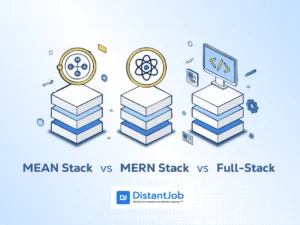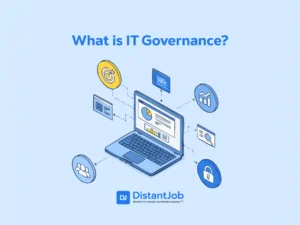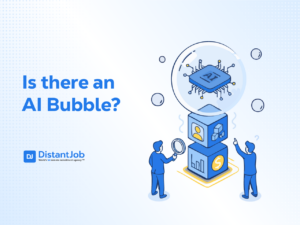DevOps has become a cornerstone of modern software development, bridging the gap between development and IT operations for faster and more reliable delivery. It’s now mainstream in organizations worldwide – in fact, 99% of companies report positive impacts after adopting DevOps practices. As we look at DevOps trends 2025, it’s clear that DevOps is continuing to evolve with cutting-edge technologies and a heightened focus on automation and security.
Polaris Market Research evaluated the global DevOps market at USD 10.5 billion in 2023 and forecasts growth at a CAGR of 21.20% during 2024-2032.
In this conversational guide, we’ll explore the future of DevOps – from AI-driven automation and security integration (DevSecOps) to new CI/CD automation trends – and share DevOps 2025 predictions for how these changes will shape software development and business operations.
NoOps and Hyper-Automation
One of the most prominent DevOps trends in 2025 is NoOps. NoOps is a model where IT operations are automated with minimal human intervention. NoOps is possible by using the following technologies: serverless computing (like AWS Lambda, Azure Functions), AI-driven auto-healing infrastructure, and self-managed Kubernetes clusters.
In short, NoOps reduces manual effort, improves efficiency, and accelerates software delivery and operation.
AI/ML Auto-Driven Self-Healing
AI-driven systems are self-healing, automatically detecting anomalies and resolving issues without human intervention to minimize downtime. Here are the benefits of using AI to fix your code:
Predictive incident management
AI models analyze logs and metrics to spot warning signs and notify teams of potential failures, enabling a proactive approach to problem-solving.
Intelligent test automation
ML-based tools automatically create and run test suites when code changes, ensuring new code is thoroughly tested and reducing the burden on QA engineers.
Self-healing systems
Advanced platforms leverage AI to auto-remediate infrastructure or application issues – for instance, restarting failed services or scaling resources – without waiting for human intervention.
Serverless Architecture
Serverless Architecture is a trend of its own, and we will talk about it later. But for now, let’s just say that serverless computing allows developers to focus purely on writing code. No server management, no underlying infrastructure management. It minimizes human intervention for all NoOps intents.
Hyper Automation with Kubernetes
Kubernetes automates tasks like deploying applications, rolling out changes, scaling up or down, monitoring, and more. When you add self-management capability, driven by AI and ML, you get a fully automated tool for CD/CI and deployment.
Security-First: DevSecOps
Another major focus in 2025 DevOps trends is security at every step – often referred to as DevSecOps (Development + Security + Operations). DevSecOps adds security to the DevOps mix. It embeds security measures throughout the software development lifecycle and encourages collaboration among developers, security specialists, and the operations team. Security is integrated in every step of the development cycle, baked into the lifecycle. The goal is to build security into the product from the outset
A core DevSecOps principle is “shift left”, which means integrating security measures early in development. Instead of waiting until after deployment to address first-exploited vulnerabilities, “shift left” ensures security vulnerabilities are identified and addressed during the coding phase. It minimizes the risks of breaches and reduces the cost of fixing vulnerabilities
Automated Security Testing
Automated security testing is becoming standard – tools perform static code analysis, dependency checks, and dynamic testing in the CI/CD pipeline without slowing developers down. Security issues that might have gone undetected until a final audit are now caught by these tools in real-time.
Types of automated security testing include:
Static Application Security Testing (SAST)
Analyzing source code for security vulnerabilities without executing the program and static code security analysis.
Dynamic Application Security Testing (DAST)
Testing running applications for vulnerabilities through simulated attacks.
Runtime Application Self-Protection (RASP)
Automated security testing in CI/CD pipelines is listed with SAST and DAST under DevSecOps benefits.
Software Composition Analysis (SCA)
Identifying and managing risks in open-source components and dependencies.
Security as Code
Another practice is treating security as code, where security policies and configurations are managed through code and version control (similar to how infrastructure is managed). This ensures consistency and repeatability: the same security settings apply across all environments, and any changes are tracked. DevOps teams and security teams thus work hand-in-hand, using common platforms and languages.
DevSecOps Tools
Some recommended tools for DevSecOps are: Snyk, for automated vulnerability scanning; Aqua Security, for container security and scanning Docker/Kubernetes environments; and Checkmarx static code security analysis.
DORA (Regulatory Drivers)
Regulatory requirements, such as the EU’s Digital Operational Resilience Act (DORA), are driving DevSecOps practice. These regulations require organizations to prioritize security and digital resilience. That’s practically “Regulation as Code”.
DevSecOps helps prevent the “release now, patch later” mentality. The payoff is safer applications and faster approvals to release. If security is built in, fewer eleventh-hour surprises hold up deployment.
GitOps and Everything as Code
Many organizations are turning to a DevOps Trend in 2025 known as GitOps. GitOps is an approach that treats Git as the single source of truth for both code and infrastructure. Consider that you might turn your infrastructure into whatever you need using Infrastructure as Code (IaC). As a version control tool, Git can do and undo any change on both code and infrastructure. It gives you the power to automate these changes and deploy faster as well.
In 2023, GitOps was a DevOps trend adopted by 91% of respondents in a Cloud Native Computing Foundation survey.
Infrastructure as Code
As GitOps requires IaC, Infrastructure as Code (IaC) is a foundational practice as a DevOps trend for the present and the future of DevOps. IaC helps manage infrastructure and application configurations with much better reliability.
IaC ensures infrastructure is deployed consistently and repeatably across all stages of the software development lifecycle. Defining infrastructure through code that executes automatically ensures consistency across environments. IaC also benefits from version control, allowing monitoring and organization of infrastructure changes using familiar systems. You can use several tools for IaC and its automation
Terraform is a tool for multi-cloud IaC automation. It is also a popular IaC tool used to define and manage infrastructure through code, ensuring consistency and repeatability.
Pulumi is a tool for code-driven infrastructure. Crossplane does that as well, just is involved with Kubernetes-native IaC management. Ansible, Puppet, and Chef are configuration management tools used to define and manage infrastructure through code.
Docker is a platform-as-a-service (PaaS) tool enabling software delivery in containers and is used in DevOps workflows for automated build and deployment. Knowing how to use Docker is key in the DevOps tech stack and is used with Kubernetes in cloud-native architectures.
Kubernetes is used for Crossplane for IaC, for serverless applications with KNative, continuous delivery with Argo CD, and is the leading container orchestration platform used for managing containers and orchestrating services in cloud environments. DevOps methodologies are well-suited to containerization technologies like Docker and Kubernetes. Expect Kubernetes to remain the primary workload orchestration system beyond 2025, in the future of DevOps.
GitOps Tools
Flux implements the core principles of GitOps by continuously observing the state defined in a Git repository and ensuring that the actual state of the Kubernetes cluster matches it. Argo CD facilitates the continuous delivery aspect of GitOps by automating deployments based on the state defined in a Git repository. It can automatically deploy application changes when it detects new configurations in Git.
In the larger context of GitOps and IaC, these tools play a crucial role. GitOps leverages IaC by using Git repositories as the single source of truth for declarative infrastructure defined as code,. This allows teams to use familiar Git workflows for managing infrastructure deployments, making the process more reliable, auditable, and version-controlled. IaC tools automate the technical execution based on the desired state defined in Git.
Serverless Architectures and Cloud-Native
Serverless computing and cloud-native architectures are a major focus for the future of DevOps teams in 2025. While serverless computing allows developers to concentrate on writing application code without worrying about infrastructure management, Cloud-Native DevOps involves replacing traditional monolithic applications with more modular and scalable microservices. Together, they lead to increased efficiency and faster development cycles.
Serverless CD/CI
Serverless CI/CD pipelines made it easier for DevOps teams to build and deploy applications. They don’t have to worry about managing infrastructure.
Serverless platforms like AWS Lambda, Azure Functions, and Google Cloud Functions allow teams to focus on application logic while the platform automatically scales to meet demand.
Cloud Native Tools
Kubernetes, Docker, and Prometheus help teams manage a microservices-based architecture. They enable greater scalability and resilience in applications.
Event-Driven Architecture
Event-Driven Architectures (EDAs) are a crucial element intrinsically tied to serverless computing. In an event-driven architecture model, applications respond to triggers. These triggers can include things like requests or database changes, contrasting with traditional monolithic processes.
EDA ensures efficient resource utilization. Since applications are designed to respond to events, resources are only consumed when an event occurs! It avoids the inefficiency of paying for idle time associated with traditional server hosting.
EDA also allows for application scaling with little effort. When traffic or the number of events increases, the system can automatically allocate more resources to meet demand. It supports the serverless benefit of handling sudden traffic surges with scalability without limits.
Multi-Cloud and Hybrid Cloud Strategies
As companies embrace the benefits of cloud technologies, they are moving beyond relying solely on a single cloud provider or exclusively on cloud-based infrastructure. The strategic choice to implement multi-cloud (using services from multiple public clouds) or hybrid cloud (combining public cloud resources with on-premises infrastructure) is becoming more common for flexibility and resilience.
Observability and Monitoring Evolution
Observability is a critical trend within the modern DevOps landscape for 2025. It has evolved significantly from traditional monitoring and is no longer considered an afterthought. Instead of merely detecting issues, observability aims to know why problems occur in real-time. It helps the team to evaluate impacts on the entire system. This shift enables proactive problem resolution before end-users are affected.
Enhanced observability relies on technologies such as real-time telemetry (continuous data collection and analysis), distributed tracing (crucial for microservices to follow request paths and identify bottlenecks), and advanced log analytics tools.
Beyond Traditional Monitoring
Traditional monitoring focused on simply detecting issues. Observability provides context around alerts rather than just notifying about symptoms. It facilitates correlation between user experience and system performance and supports business impact analysis of technical issues.
Unified Observability Platforms
A DevOps trend in 2025 is the rise of unified observability platforms like Prometheus, Grafana, and OpenTelemetry. These platforms consolidate data from different system components, including metrics, logs, and traces, into a single, integrated view. This aggregation gives DevOps teams a comprehensive understanding of system performance. It helps them correlate events across different parts of the infrastructure, code, and CD/CI pipelines.
Full-stack Observability
A key trend in Observability for 2025 is the move towards full-stack observability. This approach emphasizes understanding not just what happened but why it happened. It requires collecting and analyzing data across all layers of an application and infrastructure, correlating user experience with system performance, and supporting the analysis of the business impact of technical issues.
Platform Engineering and the Evolving DevOps Team
Platform Engineering is a significant DevOps trend for 2025 and beyond. It focuses primarily on enhancing Developer Experience (DevEx) and boosting overall productivity. To achieve it, you must create and maintain internal developer portals (IDPs), providing self-service tools that aim to simplify infrastructure complexity. So, even before developing an application, they create a platform where all the tools needed are ready to use.
According to Puppet’s 2023 State of Platform Engineering, 94% of companies find that Platform Engineering fully leverages DevOps benefits.
Rise of Internal Developer Portals (IDPs)
The platform engineering team builds an Internal Developer Platform (IDP). An IDP is a user-centric environment that integrates various tools, services, and workflows needed throughout the Software Development Lifecycle (SDLC). It’s like building a custom, integrated workstation with all the necessary tools perfectly arranged and automated.
Before Platform Engineering, developers would have to manually set up environments, configure tools, manage deployments, and jump between many disparate systems for different stages of the SDLC (coding, testing, deploying, monitoring, etc.). This is like having a toolkit where each tool is from a different manufacturer, requires its own manual, and doesn’t quite fit together.
The benefits are as follows:
- Minimizes friction
- Ensures intuitive, self-service workflows
- Fostering developer independence
- Implements continuous improvement by regularly collecting feedback
- Uses thoughtful metrics to track effectiveness (throughput, stability, satisfaction)
Popular tools for Platform Engineering include Atmosly, Backstage, Humanitec, and Cortex, which are Internal Developer Portals or cloud-native developer platforms. Enhancing Developer Productivity
In summary, Platform Engineering is positioned as a key strategy in the 2025 DevOps landscape to significantly boost developer productivity and improve their overall experience by providing user-centric, self-service platforms that abstract away underlying infrastructure complexities.
Future of CI/CD Automation in 2025
“Smarter, Faster, and More Scalable Pipelines”. This is what the future of DevOps holds for the future of CI/CD in 2025. The drive towards making these pipelines smarter, faster, and more scalable is fueled by the need for faster application delivery, high business productivity, and reducing time to market. Automation remains central to DevOps practices in 2025, with increasing emphasis on leveraging AI/ML to optimize CI/CD pipelines further.
Event-driven pipelines
Event-driven pipelines reduce delays in the CI/CD process. They are seen as contributing to the goal of achieving faster and more reliable releases, especially when getting new data in terms of minutes or seconds is key. They need high observability and robust error handling, ideal for AI embedded with real-time responsiveness.
Popular Tools
We already mentioned Argo CD within the context of the continued growth of Cloud-Native and Serverless Architectures. For CI/CD pipelines, it’s worth mentioning two more tools. Jenkins X is a key tool for automation in DevOps Workflows, driving efficiency and speed, self-hosted in Kubernetes. GitHub Actions eliminates much of the infrastructure management required by Jenkins X, you just need GitHub.
Overall, the CI/CD pipeline in 2025 is becoming smarter and more streamlined. It’s event-driven, heavily automated, and closely monitored. Continuous Integration and Continuous Delivery (CI/CD) practices remain at the heart of DevOps, and they too are advancing with new tools and techniques. CI/CD automation trends in 2025 center on making pipelines faster, smarter, and safer.
Conclusion
Looking ahead, the future of DevOps promises even tighter integration of these trends and a broader impact on how businesses operate. AI/ML integration in all facets of DevOps, from smarter incident management to AI-assisted coding and configuration suggestions. Security will remain front and center, with DevSecOps principles becoming standard practice across the board. The notion of platform engineering means that developer experience will be a priority. It means companies will invest in personalized tools and training to help their engineering teams move faster and more autonomously.





